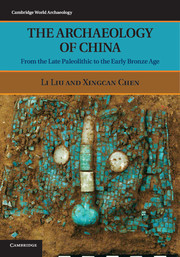Book contents
- Frontmatter
- Contents
- Illustrations
- Tables
- Preface
- Chapter 1 Chinese archaeology: Past, present, and future
- Chapter 2 Environment and ecology
- Chapter 3 Foragers and collectors in the Pleistocene-Holocene transition (24,000–9000 cal. BP)
- Chapter 4 Domestication of plants and animals
- Chapter 5 Neolithization: Sedentism and food production in the early Neolithic (7000–5000 BC)
- Chapter 6 Emergence of social inequality – The middle Neolithic (5000–3000 BC)
- Chapter 7 Rise and fall of early complex societies: The late neolithic (3000–2000 BC)
- Chapter 8 Formation of early states in the Central Plain: Erlitou and Erligang (1900/1800–1250 BC)
- Chapter 9 Bronze cultures of the northern frontiers and beyond during the early second millennium BC
- Chapter 10 The late shang dynasty and its neighbors (1250–1046 BC)
- Chapter 11 Chinese civilization in comparative perspective
- Appendix Horse bones in faunal assemblages from Neolithic and early Bronze Age sites in north China
- Glossary
- References
- Index
Chapter 11 - Chinese civilization in comparative perspective
Published online by Cambridge University Press: 05 June 2012
- Frontmatter
- Contents
- Illustrations
- Tables
- Preface
- Chapter 1 Chinese archaeology: Past, present, and future
- Chapter 2 Environment and ecology
- Chapter 3 Foragers and collectors in the Pleistocene-Holocene transition (24,000–9000 cal. BP)
- Chapter 4 Domestication of plants and animals
- Chapter 5 Neolithization: Sedentism and food production in the early Neolithic (7000–5000 BC)
- Chapter 6 Emergence of social inequality – The middle Neolithic (5000–3000 BC)
- Chapter 7 Rise and fall of early complex societies: The late neolithic (3000–2000 BC)
- Chapter 8 Formation of early states in the Central Plain: Erlitou and Erligang (1900/1800–1250 BC)
- Chapter 9 Bronze cultures of the northern frontiers and beyond during the early second millennium BC
- Chapter 10 The late shang dynasty and its neighbors (1250–1046 BC)
- Chapter 11 Chinese civilization in comparative perspective
- Appendix Horse bones in faunal assemblages from Neolithic and early Bronze Age sites in north China
- Glossary
- References
- Index
Summary
We are in the midst of a Golden Age of Chinese archaeology, because we have the opportunity to witness the creation of a completely new body of knowledge concerning the prehistory of a quarter of all humanity.
Kwang-chih Chang 1986a: 412Throughout this book we have noted marked diversities among regional cultural traditions in China. If viewed from a global perspective, however, are there any unique characteristics that distinguish early Chinese cultures from those in other regions? In this final chapter we will broaden our scope, while attempting to understand ancient Chinese civilization in comparison with civilizations in other parts of the world.
INTERPRETING CHINESENESS
Scholars from various intellectual backgrounds have been fascinated by questions like the following: How was Chinese civilization different from other civilizations in the world?What made Chinese “Chinese”?What held Chinese society together for so many centuries? These broad issues have been addressed by anthropologists, archaeologists, and historians, who often have used various analytical methods and reached different conclusions.
It is commonly acknowledged that some features characteristic of many civilizations in the world were also developed in ancient China by the second millennium BC. These features include urbanization, palatial structures, temples, metallurgy, a writing system, and institutionalized social stratification. Some of these traits, however, are only superficially similar among civilizations. When investigating each attribute in detail, marked differences are observable. As outlined by K. C. Chang (1983, 1984, 1986a) in several publications, in ancient China bronze metallurgy was applied to politics, in the form of ritual vessels and weapons, rather than to food production, whereas stone tools for agriculture remained the same from the Neolithic to the Bronze Age; the earliest surviving Chinese written records, dated to the late Shang, appear in oracle-bone inscriptions and are mainly concerned with divination; and the earliest cities were built as political centers rather than as economic foci.
- Type
- Chapter
- Information
- The Archaeology of ChinaFrom the Late Paleolithic to the Early Bronze Age, pp. 392 - 400Publisher: Cambridge University PressPrint publication year: 2012

